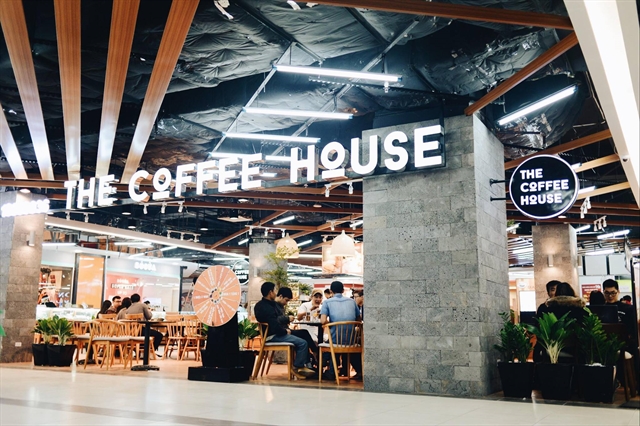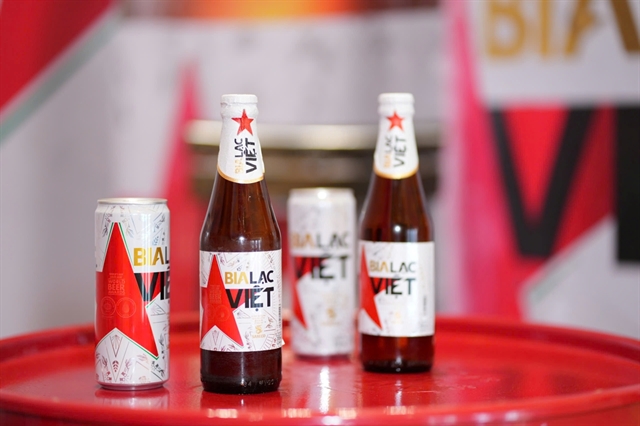 Business Beat
Business Beat


|
| A shop of The Coffee House cafe chains. — Photo bnews.vn |
Compiled by Thiên Lý
In November The Coffee House, one of the country’s major cafe chains, opened its first takeout kiosk under the brand name TCH NOW.
The small kiosk near Kingfoodmart in HCM City’s BìnhChánh rural district was a response by Coffee House to the severe impact the Covid-19 pandemic had on it like on many other coffee chains.
Besides near supermarkets, it also plans to open mobile kiosks on pavements in the hope of reaching out to a large number of customers.
The HCM City- based chain, established in 2014, had over 100 stores nation-wide before the pandemic began.
Packaged food producer KIDO Group has also adopted the mobile kiosk model to expand its coffee market share.
The kiosks sell the Chuk Chuk brand of products including coffee.
In July this year, it opened a chain of stores in HCM City selling the ChukChuk brand of ice cream, milk tea, tea, coffee, and fresh bakery products with an investment of VNĐ100 billion (US$4.4 million).
With 1,000 stores likely to be opened across the country by 2025, Chuk Chuk is expected to become a leading brand.
The company’s general director, Trần Lệ Nguyên, said the first outlets opened in HCM City and the others are due to open in Hà Nội and some northern provinces once the pandemic is controlled.
The timing is curious to say the least considering the economy has been impacted by the pandemic.
But The Coffee House and Kidoare not the first coffee chains to embrace the takeaway model.
Highlands Coffee, with 262 cafes across HCM City and the leader of the medium and high-end markets, was one of the pioneers in this business model, putting up kiosks in late 2019 to sell takeaway coffee.
A seller at a Highlands Coffee kiosk on Nguyễn Oanh Street said before the pandemic she would open her stall for only two hours from 7 am but would still sell dozens of cups of coffee. The price of a cup at that time was VNĐ29,000, VNĐ10,000 less than in the chain’s cafes.
“We opened the shops on pavements because we wanted to serve customers who do not have much time but still want to buy their favourite drinks.”
The Passio café chain sent staff to hawk takeaway on streets at a reasonable VNĐ19,000.
A spokesperson said a few years ago Passio cafes were always full, but it then had to compete fiercely with other chains and so had to try other ways to attract customers, including by offering takeaway.
Trung Nguyên Legend franchises E-Coffee with the business model being small shops of up to 40 square meters selling low-to mid-priced coffee to busy customers.
But the takeaway model really came into its own when the pandemic hit the country since it allowed cafes to keep their business going and their brands in the public eye.
Most of the big brands adopted the model in early 2020 as revenues from their traditional business with modern and convenient outlets situated at premier locations fell steeply.
The CEO of a big coffee chain in HCMC said 70 per cent of coffee chains and cafes of all sizes suffered big losses since they had to suspend their business for a long time when the city was struck by the fourth wave of Covid and social distancing was imposed for a long period.
HoàngVănTiến, CEO of Coffee Bike, said he had to shut down 10 of the chain’s 15 cafes this year, but opened 35 roadside kiosks.
Besides HCM City, the kiosks have also been set up in Hà Nội and southern provinces like Đồng Nai, Bình Dương and Bình Phước.
Market Potential
The question is nevertheless asked: Will the new takeaway coffee chains also get into a difficult situation as many traditional cafes have?
After all, even Starbucks, the world’s leading cafe brand, decided to close its store at the Rex Hotel in HCM City even as the government announced a gradual reopening.
The short but resounding answer from analysts is “no.”
They believe the cafe market continues to have solid potential especially takeout.
According to CBRE Vietnam, in 2020 the number of coffee chains in the country increased by more than 10 per cent, making the coffee segment the only one to achieved positive growth in the F&B industry.
Explaining this phenomenon, an analyst said drinking coffee has become a daily habit for many and so the beverage was not in the list of products cut by consumers despite the financial difficulties caused by the pandemic.
Euromonitor said Việt Nam’s coffee and tea market is valued at around US$1 billion a year, but there are no brands with an overwhelming share in it.
The big players now like Highlands Coffee, Starbucks, The Coffee House, Phúc Long, and Trung Nguyên only have a combined 20 per cent market share.
A study by the World Bank found that the Vietnamese cafe market can consume 70,000 tonnes of coffee a year.
The takeout coffee players enjoy not only the advantages of this market potential but also their own unique strengths that keep them in good stead.
Unique advantages
Most takeaway business models including mobile stalls and roadside kiosks offer advantages like low investment, ease of operation and quick profits that have encouraged businesses in the F & B sector to adopt them.
A franchisee of a takeout coffee chain in HCM City’s Tân Bình District said an investment of around VNĐ350 million ($15,186) is required to open a traditional café whereas for a mobile kiosk it could be as little as VNĐ50 million ($2,165).
“Such a stall only needs two employees to run smoothly,” he added.
Not surprisingly, these takeaway kiosks are able to offer customers products for as cheap as VNĐ13,000-15,000 ($0.56 - 0.65).
A stall can thus sell 100-150 items a day for daily sales of VNĐ1.5-2.25 million ($65-97) and a monthly profit of VNĐ15 million ($648).
Analysts said the model also offers low risk and helps build a brand and market products.
According to coffee chains, the target customers of kiosks are young people.
Another very important advantage is that the takeout business model meets demand, especially in a market where consumer habits have changed due to the Covid-19 pandemic.
The current trend is that people prefer to avoid crowds, especially at stores, instead of being ready to join the crowds unlike in the past. — VNS




